Hidden Agenda
Koganecho Bazaar, Yokohama, Japan
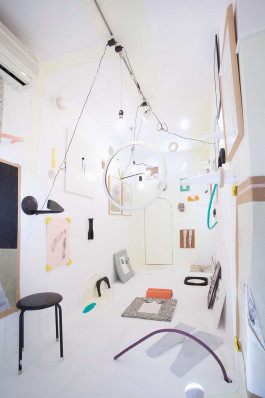
Hidden Agenda was an exhibition project in a former Japanese red-light district that has been transformed into a government-funded urban development project: Koganecho Bazaar in Yokohama, Japan. International artists were invited to develop installations in former brothels in order to revitalise the abandoned, partially stigmatised area. These former brothels are very distinctive buildings, built specifically for their purpose: small houses with a large window in the front to showcase the women who work there.
The rooms of the houses are very small to accommodate as many sex workers as possible.
These special buildings have now been entrusted to artists who have been commissioned to create installations there.
Verena Issel’s installation dealt with the history of the place.
On the prominent entrance door was a text by British film theorist Laura Mulvey:
“The cinematic apparatus of classical Hollywood cinema inevitably puts the spectator in a masculine subject position, with the figure of the woman on screen as the object of desire and the ‘male gaze.’ Viewers are encouraged to identify with the protagonists, who were and still are overwhelmingly male. Meanwhile, Hollywood women characters are often coded with ‘to-be-looked-at-ness’ while the camera positioning and the male viewer constitutes the ‘bearer of the look.’ This look is adapted by females to judge both other females and themselves with male measuring rods.”
Visitors entered a very bright entrance room, lightly painted and with a friendly atmosphere created by many small playful light sources. Here they were greeted by an installation consisting of many playful small objects spread across the walls, floor and ceiling.
The objects were all painted in bright pastel colors, making them seem small and harmless. This could be seen as a reference to the schoolgirl aesthetic of the neighbouring sex workers.
It took a second look to discover sexual allusions in almost all of the objects.
A third look revealed a tiny door hidden in the wall, which the artist had specially installed.
Entering through this door, the visitor was greeted by a collage by Issel depicting a sad woman.
Behind this small door, the former brothel was no longer renovated and brightly painted like the front area, but visitors were suddenly standing on the original tatami mats on which the sex workers used to work; the walls were worn and showed various traces of what had been there before.
In the back workrooms were small sculptures by Verena Issel.
A reading room was set up in
the last room. Verena Issel had spent several months collecting and transcribing the life stories
of local sex workers.
In order to prevent these personal, explicit texts from being photographed and distributed without permission, the room was lit with blue-black light, making it very difficult to photograph the texts with mobile phones.
Visitors to the exhibition were invited to engage with the history of the place and the fate of the people who lived and worked there.
Issel tries to walk a tightrope here: to show the true face of the place, with all its sad facets, but also to allow for beauty in this rather dark place.
☐ Uwe Carlson
INGREDIENTS:
- Male Gaze
- Pervy Fuji
- Unterbüxe
- Legs
- Pants Down
- Boobs
- House of the rising sun I
- House of the rising sun II
- Sperminator
- Grab Grab
- Sunglasses At Night
- Pimmeli
- Yoko
- Ballz
- Moriko
- Hai Hai
- Male Fuji
- Sunglasses At Night II
- False Affection (Pink Cube)
- Sad Madonna
- 13 Life stories
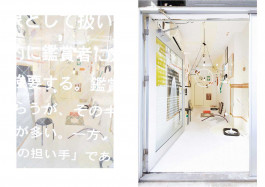

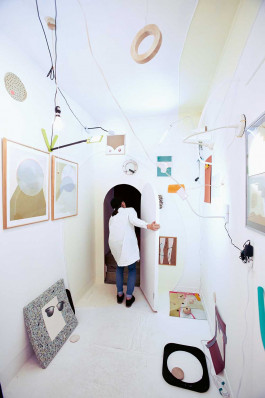
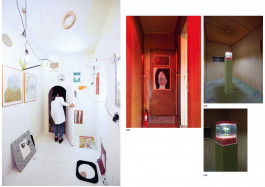
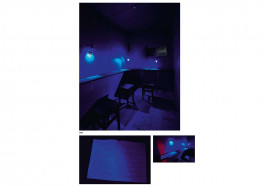
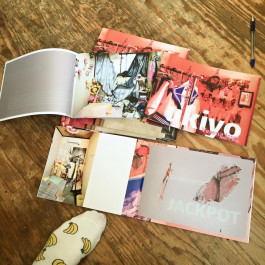
Hidden Agenda Entrance door with text
Hidden Agenda
2015, various objects and materials,
room dimensions: 2.40 × 6 × 3 m,
Installation view Koganecho Bazaar, Yokohama, Japan
Photo: Yasuki Kagi
Hidden Agenda
2015, various objects and materials,
room dimensions: 2.40 × 6 × 3 m,
Installation view Koganecho Bazaar, Yokohama, Japan
Photo: Yasuki Kagi
Entrance to the hidden back room through a “secret” door specially built into the installation
Hidden Agenda
2015, various objects and materials,
room dimensions:
2.40 × 6 × 3 m,
Exhibition in a former Japanese brothel, state-financed urban development project, Koganecho Bazaar, Yokohama, Japan
The hallway behind the hidden door
Hidden Agenda
2015, various objects and materials,
room dimensions
2.40 × 6 × 3 m,
Installation view Koganecho Bazaar, Yokohama, Japan,
Hidden Agenda
2015, first of two hidden back rooms: False affection (pink cube), 2015, original tatami mats, left behind by the sex workers, wooden base, with plant incubator, plastic, lighting, plastic basil, 160 × 24 × 24 cm
Hidden Agenda 2015, first of two hidden back rooms: False affection (pink cube), 2015 Original tatami mats, left behind by the sex workers, wooden base, with plant incubator, plastic, lighting, plastic basil, 160 × 24 × 24 cm
Hidden Agenda 2015
Second of two hidden back rooms: Living/Living room, 2015, original tatami mats left behind by the sex workers who worked in this room before, wooden desk and chairs, photo inhibiting blue light and textbooks with
the collected life stories of sex workers from Yokohama
UKIYO
Artist book, in collaboration with John L. Tran
A5 format, 32 pages. Book design: Franziska Nast. Concept and idea: Verena Issel. Photography: John L. Tran and Verena Issel. Published with the support of Hamburger Kulturbehörde, 2016.
Photographs of a brothel in Yokohama, Japan, abandoned 20 years ago and untouched ever since. The images are overlaid with lottery scratch-off ink, printed with the life stories of the prostitutes who once worked there. In order to see the photographs, the viewer must scratch away the personal histories.
The life stories of Japanese sex workers, collected for the exhibition HIDDEN AGENDA, formed the basis for the publication UKIYO.
For this book, documentary-style photographs of a brothel in Yokohama—hastily abandoned in the 1990s due to forced eviction—were combined with personal narratives. During my research into the lives of former prostitutes in the area, I became acquainted with several of the women. One of them eventually led me to a very special place: the old brothel where she had once worked.
In the 1990s, the brothel had been forcibly cleared, and those working there had fled in fear of both the police and the yakuza. Due to an ongoing dispute over ownership of the building, it has remained untouched ever since. Like a time capsule, everything inside has been preserved exactly as it was at the moment of their flight. My acquaintance still had her old key and secretly allowed me to photograph the interior.
For UKIYO, I combined these photographs with the life stories of women from Yokohama. The images were printed first, then covered with lottery-style scratch-off ink, and finally overprinted with the personal narratives of the women who had once worked there.
To view the images, the reader must physically scratch off the stories using a coin. One must choose: what do you want to see, and what do you want to know?